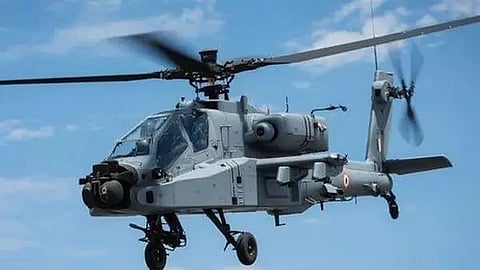
- Home
- Live Blog
- Breaking News
- Top Headlines
- Cities
- NE News
- Sentinel Media
- Sports
- Education
- Jobs

Rahul Kamble
(rahulkamble01433@gmail.com)
In a major
boost to 'Make in India' in defence, The Indian Air Force is set to induct the
'Made-in-India' Light Combat Helicopter (LCH) at the Jodhpur Air Force Station
on October 3, 2022; making it the most lightweight helicopter to become part of
the Indian defence forces giving impetus to high-altitude counter-insurgency
operations.
This cardinal move comes amidst a paradigm shift in the Indian Aerospace and Defence walks. Designed, developed and manufactured by Hindustan Aeronautics Limited (HAL), the IAF will get 10 helicopters and the Indian Army will get five. On board, the indigenous content is about 45 per cent by value and this is expected to go up to 55 per cent for Series Production Version. In June this year, the Indian Army has already raised its first LCH squadron in Bengaluru and the unit is expected to move to Eastern Command along the Line of Actual Control on the completion of the raising in 2023. The army's requirement is 95 machines in seven units. Typically each unit has 10 helicopters, and these are expected to be deployed in combat roles in mountainous terrain. For the Indian Army, the LCH is the first dedicated attack helicopter in its fleet. It operates 75 Rudra helicopters, the weaponized variant of the indigenous Advanced Light Helicopter. In 2024, the Army is expected to start receiving Apache attack helicopters from the US through the Foreign Military Sales route. It has contracted for six under an approximate $800-million deal from the US in 2020 and is also in talks with the US Boeing Company for the procurement of 11 additional Apache helicopters. The LCH can prove to be a game changer in the array of operating options offered by it. Except for the Soviet-era Mi-35s, India has always lacked a dedicated attack helicopter in its fleet.
The genesis of the LCH lies in the Kargil conflict of 1999 when the absence of an attack helicopter which could operate in ultra-high altitude areas was felt acutely by the Indian Army and the Indian Air Force (IAF). The intruding Pakistan Army troops had occupied various heights on the Indian side of the Line of Control but the existing Russian-made attack helicopters in the inventory of the Indian military did not have the operational ceiling which permitted their deployment at those heights. The IAF was forced to use the MI-17 helicopters in a modified role against those heights and suffered the loss of a helicopter when it was fired upon by the enemy. 1999 revealed that the Indian armed forces lacked a suitably armed rotorcraft capable of operating and specifically carrying out combat operations unrestricted in the high-altitude theatre. It was in 2006 that Hindustan Aeronautics Limited (HAL) announced its intention to develop an LCH which could operate in the harsh desert conditions as well as the high-altitude areas of Ladakh including the Siachen Glacier. The first ground run of the prototype of the LCH took place in February 2010 and a month later the first flight test of the helicopter also took place.
Traditionally, India has not been a familiar figure to combat birds of the LCH Class. There were no attack helicopters in IAF until November 1983. India had a small fleet of unarmed light helicopters HAL manufactured Chetak and Cheetah. IAF procured Russian-origin MI4 helicopters as troop carriers and helidrop missions in the early 1960s. They were replaced by medium-lift MI8 again of USSR origin in 1975, which could carry 20 armed troops. We never had an attack helicopter during the 1962, 1965 and 1971 wars.
The LCH is well suited for the anti-tank role wherein it can fly low and fast to attack enemy armour columns and destroy them. As per HAL, it is also suitable for the scout role wherein it can fly ahead of advancing columns of the Army and detect enemy presence. It is also suitable for air defence roles and the destruction of enemy air defence assets. It can also be used in urban warfare missions and combat search and rescue operations. The helicopter has several stealth features and has armour protection, night attack capability and crash-worthy landing gear to give it better survivability. It is powered by two Shakti engines and has a maximum take-off weight of 5,800 kg. With a maximum speed of 268 km per hour, it has a range of 550 km and an operational ceiling of 6.5 km. Armed with air-to-air and air-to-ground missiles, LCH also has a 20 mm gun and 70 mm rockets. With a full glass cockpit, the LCH has an Electronic Warfare suite and helmet-mounted display for the flying crew.
Under the 'Aatmanirbhar Bharat' mission, the Indian Aerospace and Defence sector has been identified as one of the key focus areas. There have been various policy changes signalling the end of an era of import dependence and aim to promote India as the most preferred global manufacturing destination for foreign Tier-1 vendors. India has been at the forefront of the development of Light Combat Aircraft. India's LCA Tejas has been hogging the global media limelight with its spectacular display at international air shows, including in Dubai and Singapore. With LCH, India looks to replicate the 'success' of Tejas. With the fire of the Dragon lingering in Eastern Ladakh, induction of LCH is rather a powerful statement, of Delhi being combat ready.